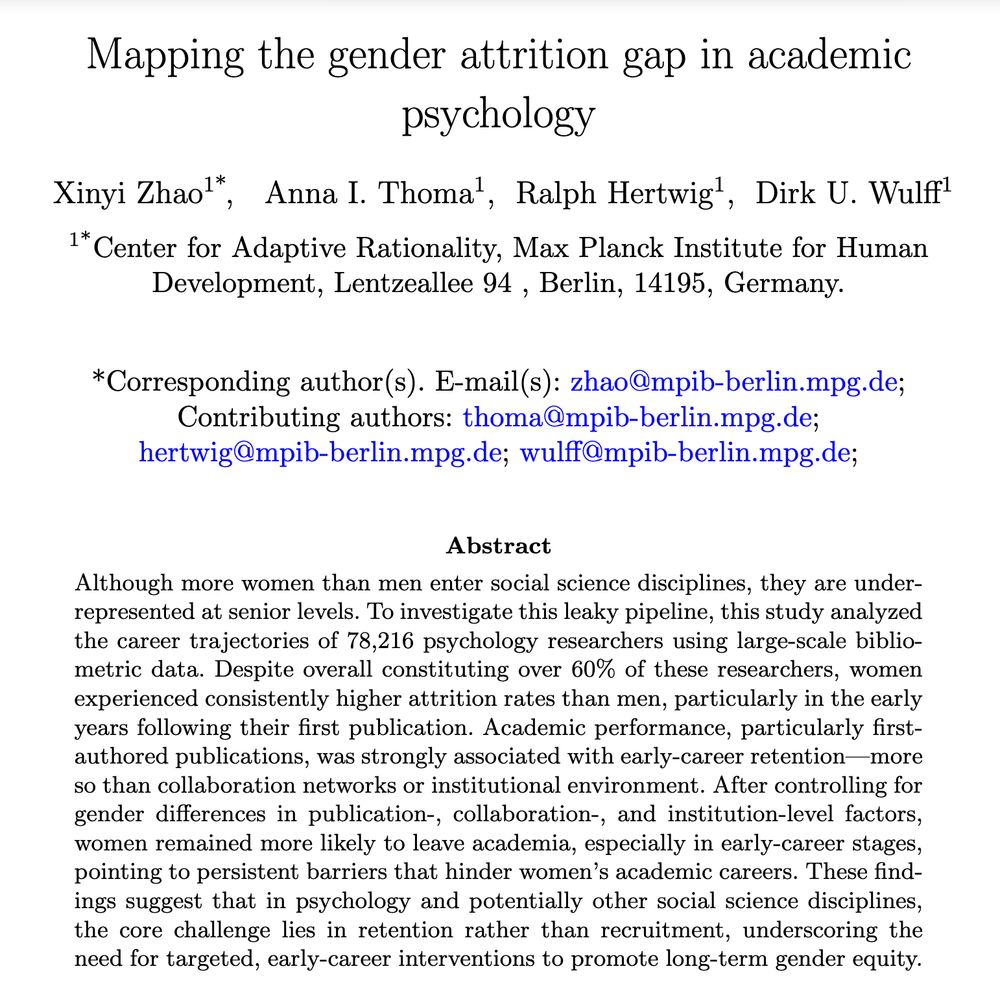
Our New Paper is out in Nature Human Behaviour: 🚨 Culture is critical in driving orangutan diet development past individual potentials! 🦧 www.nature.com/articles/s41.... See 🧵
24.11.2025 11:05 — 👍 69 🔁 28 💬 3 📌 9@dominikdeffner.bsky.social
Assistant Professor for Computational Modelling of Behaviour @unimarburg.bsky.social | (Social) decision-making and (cultural) evolution | Website: https://www.uni-marburg.de/en/fb04/team-deffner/deffner

Our New Paper is out in Nature Human Behaviour: 🚨 Culture is critical in driving orangutan diet development past individual potentials! 🦧 www.nature.com/articles/s41.... See 🧵
24.11.2025 11:05 — 👍 69 🔁 28 💬 3 📌 9Postdoc position in individual-level incentives, social
learning, and payoff-biased imitation shape group-level accuracy in complex prediction and decision-making tasks in Konstanz
files.newsletter2go.com/l3slzozn/s_i...

Fully funded #PhDposition in Comparative Cultural Psychology @mpi-eva-leipzig.bsky.social.
We will use touchscreen experiments & eyetracking to study mental simulations in nonhuman apes & human children across different cultures.
All info here: www.eva.mpg.de/career/posit...
Please share / apply!🙏

Each dyad (a, b) moves through four discrete states over time, represented by coloured circles. The dyad remains in a given state for a certain duration, or "holding time", before transitioning to a new state according to state-specific transition probabilities, indicated by arrows showing all possible (non-zero) transitions. Paintings by Sofia M. Pereira & Judith von Nordheim.
New paper!
We propose a framework to empirically study animal social relationships by modelling social network (SN) data as time-series—that is, without the need to aggregate them over time.
www.biorxiv.org/content/10.1...

Do people remember where things are relative to their body (e.g. my left side) or relative to the environment (the North/uphill side)? The answer is both at once, according to my new paper now out in Psychological Science! 🧵 journals.sagepub.com/doi/10.1177/...
12.11.2025 13:00 — 👍 21 🔁 7 💬 1 📌 0
A table showing profit margins of major publishers. A snippet of text related to this table is below. 1. The four-fold drain 1.1 Money Currently, academic publishing is dominated by profit-oriented, multinational companies for whom scientific knowledge is a commodity to be sold back to the academic community who created it. The dominant four are Elsevier, Springer Nature, Wiley and Taylor & Francis, which collectively generated over US$7.1 billion in revenue from journal publishing in 2024 alone, and over US$12 billion in profits between 2019 and 2024 (Table 1A). Their profit margins have always been over 30% in the last five years, and for the largest publisher (Elsevier) always over 37%. Against many comparators, across many sectors, scientific publishing is one of the most consistently profitable industries (Table S1). These financial arrangements make a substantial difference to science budgets. In 2024, 46% of Elsevier revenues and 53% of Taylor & Francis revenues were generated in North America, meaning that North American researchers were charged over US$2.27 billion by just two for-profit publishers. The Canadian research councils and the US National Science Foundation were allocated US$9.3 billion in that year.

A figure detailing the drain on researcher time. 1. The four-fold drain 1.2 Time The number of papers published each year is growing faster than the scientific workforce, with the number of papers per researcher almost doubling between 1996 and 2022 (Figure 1A). This reflects the fact that publishers’ commercial desire to publish (sell) more material has aligned well with the competitive prestige culture in which publications help secure jobs, grants, promotions, and awards. To the extent that this growth is driven by a pressure for profit, rather than scholarly imperatives, it distorts the way researchers spend their time. The publishing system depends on unpaid reviewer labour, estimated to be over 130 million unpaid hours annually in 2020 alone (9). Researchers have complained about the demands of peer-review for decades, but the scale of the problem is now worse, with editors reporting widespread difficulties recruiting reviewers. The growth in publications involves not only the authors’ time, but that of academic editors and reviewers who are dealing with so many review demands. Even more seriously, the imperative to produce ever more articles reshapes the nature of scientific inquiry. Evidence across multiple fields shows that more papers result in ‘ossification’, not new ideas (10). It may seem paradoxical that more papers can slow progress until one considers how it affects researchers’ time. While rewards remain tied to volume, prestige, and impact of publications, researchers will be nudged away from riskier, local, interdisciplinary, and long-term work. The result is a treadmill of constant activity with limited progress whereas core scholarly practices – such as reading, reflecting and engaging with others’ contributions – is de-prioritized. What looks like productivity often masks intellectual exhaustion built on a demoralizing, narrowing scientific vision.

A table of profit margins across industries. The section of text related to this table is below: 1. The four-fold drain 1.1 Money Currently, academic publishing is dominated by profit-oriented, multinational companies for whom scientific knowledge is a commodity to be sold back to the academic community who created it. The dominant four are Elsevier, Springer Nature, Wiley and Taylor & Francis, which collectively generated over US$7.1 billion in revenue from journal publishing in 2024 alone, and over US$12 billion in profits between 2019 and 2024 (Table 1A). Their profit margins have always been over 30% in the last five years, and for the largest publisher (Elsevier) always over 37%. Against many comparators, across many sectors, scientific publishing is one of the most consistently profitable industries (Table S1). These financial arrangements make a substantial difference to science budgets. In 2024, 46% of Elsevier revenues and 53% of Taylor & Francis revenues were generated in North America, meaning that North American researchers were charged over US$2.27 billion by just two for-profit publishers. The Canadian research councils and the US National Science Foundation were allocated US$9.3 billion in that year.

The costs of inaction are plain: wasted public funds, lost researcher time, compromised scientific integrity and eroded public trust. Today, the system rewards commercial publishers first, and science second. Without bold action from the funders we risk continuing to pour resources into a system that prioritizes profit over the advancement of scientific knowledge.
We wrote the Strain on scientific publishing to highlight the problems of time & trust. With a fantastic group of co-authors, we present The Drain of Scientific Publishing:
a 🧵 1/n
Drain: arxiv.org/abs/2511.04820
Strain: direct.mit.edu/qss/article/...
Oligopoly: direct.mit.edu/qss/article/...

This will spark some great papers: an open digital dataset of roads in the Roman Empire
www.nature.com/articles/d41...

Part of a startup project funded by Max Planck Innovation's MAX!mize program, we're developing next-generation software for automated analysis of animal social behavior. We have this opening:
Software Engineer (m/f/d) (80 - 100 %) Behavioral Analysis Platform Development
Details : lnkd.in/ewXgnBmV
The final paper of my dissertation has just been published in Psychometrika (@pmetricsoc.bsky.social). Many thanks to @bsiepe.bsky.social and @danielheck.bsky.social, who co-authored it with me.
www.cambridge.org/core/journal...
Does JavaScript….go hard?!??
24.10.2025 05:54 — 👍 39 🔁 5 💬 2 📌 1
New paper out today with Zhian Chen.
We argue that modern intensive parenting is not only exhausting for parents, but in some cases disrupts healthy child development.
What is 'overparenting'? And can evolutionary theory help us understand how we got here?
academic.oup.com/emph/advance...
We built the openESM database:
▶️60 openly available experience sampling datasets (16K+ participants, 740K+ obs.) in one place
▶️Harmonized (meta-)data, fully open-source software
▶️Filter & search all data, simply download via R/Python
Find out more:
🌐 openesmdata.org
📝 doi.org/10.31234/osf...
Fully-funded 4-year #PhD in Cultural Evolution! Join my @erc.europa.eu project exploring how compression & compositionality drive cultural innovation: hmc-lab.com/ERCPhDCultur...
Apply by Nov 12!
Maybe of interest to folks from #COSMOS2025 or @eslr.bsky.social? Please feel free to share! 🙏

How do humans keep inventing tools and technologies that no single person could create alone?
Our new preprint, led by
@anilyaman.bsky.social & @ts-brain.bsky.social
shows that semantic knowledge guides innovation and drives cultural evolution. 🧠📘 arxiv.org/abs/2510.12837

🚨 New preprint 🚨
Analyzing the academic trajectories of 78,216 psychology researchers, we demonstrate a persistent gender attrition gap, with women psychologists dropping out of academia at consistently higher rates than men psychologists.
Preprint: arxiv.org/pdf/2510.13273
Great to see this work finally released! Fun fact, Valerii was the winner of the #COSMOS2023 poster prize with an earlier iteration of this project
15.10.2025 15:42 — 👍 7 🔁 1 💬 0 📌 0@watarutoyokawa.bsky.social @thecharleywu.bsky.social @bjornlindstrom.bsky.social @ketikagarg.bsky.social @rdhawkins.bsky.social @shoalgroup.bsky.social @psmaldino.bsky.social
15.10.2025 08:25 — 👍 1 🔁 0 💬 0 📌 0
Thanks so much to @ralfkurvers.bsky.social and @promanczuk.bsky.social, but especially to Valerii: www.scienceofintelligence.de/people/valer... 🙏
@arc-mpib.bsky.social @mpib-berlin.bsky.social @scioi.bsky.social @unimarburg.bsky.social @humboldtuni.bsky.social

Finally, to prove our model insights could explain the observed dynamics, we developed an ABM reproducing key aspects of the behavioral data.
Simulations also provided generalizable insights beyond our experiment, revealing why collective intelligence can only emerge in certain environments.

We then used a comp model predicting movement decisions to test how private and social features guided participants' behavior.
Results confirmed that payoff information let participants selectively tune behavior to the position and direction of successful peers, unlocking collective intelligence!

Using high-resolution time-series data of participants' visual information and movement trajectories, we found that payoff information boosted performance by allowing collectives to flexibly reorganize visibility networks over time and adaptively guide information flow between group members.
15.10.2025 07:26 — 👍 0 🔁 0 💬 1 📌 0
Results show that sociality was a double-edged sword:
Groups could outperform solitary individuals through both superior tracking and search performance, but only when full payoff information was available.
In the absence of payoff information, they sometimes even performed worse!

We challenged individuals with a spatially-explicit search-and-tracking task in an immersive 3D environment.
By manipulating task complexity and the availability of social cues, we study how individuals adapt their visual attention and social learning strategies to different dynamic contexts.

Previous research (including my own) has predominantly studied these processes in simplified paradigms with unrealistic environments and predefined features!
Thus, it is largely unknown how collective intelligence can emerge in mobile human groups coping with dynamically changing environments.

Which processes underlie collective intelligence in naturalistic human groups?
In new work led by Valerii Chirkov, we show that payoff selectivity is key in transforming a group of individuals into an intelligent collective 🤝🧠
www.youtube.com/watch?v=xY7n...
Preprint: osf.io/preprints/ps...

Out today in @plosbiology.org (1/5)
Siblings and non-parental adults provide alternative pathways to cultural inheritance in juvenile great tits 🐦🧩
Link to study:
10.0.5.91/journal.pbio...
Co-authors:
@lucymaplin.bsky.social
@galarconnieto.bsky.social

EHBEA is looking for new PRESIDENT and SECRETARY for 2026-2029! 👀
If you know of anybody who could represent EHBEA, nominate them as president!
If you know with good organisational skills, nominate them as secretary!
DEADLINE: 16/12/2026
HERE IS THE FORM 👇
docs.google.com/document/d/1...

I am gonna take the option where I get more time to read, understand and write. maybe that AI can go to committee meetings for me?
07.10.2025 12:18 — 👍 32 🔁 3 💬 1 📌 0
Golden eagle on the nest in Finland (by O. Karlin)
🦅PhD position 🦅 in my new group at @fbm-unil.bsky.social in Switzerland, studying how the social and resource landscapes shape the learning process for soaring flight. Deadline: Oct 30. Pls repost! career5.successfactors.eu/career?caree...
06.10.2025 05:56 — 👍 108 🔁 80 💬 1 📌 2📢🚀 Are you an early-career researcher working on anything related to culture, behaviour or learning? 🧠🌍 Join ESLR, an interdisciplinary research community! We have a NEW website and our membership is now FREE. 👉 Sign up here to get updates and become a member: www.eslrsociety.com/membership
02.10.2025 07:43 — 👍 14 🔁 21 💬 0 📌 0